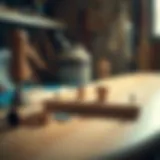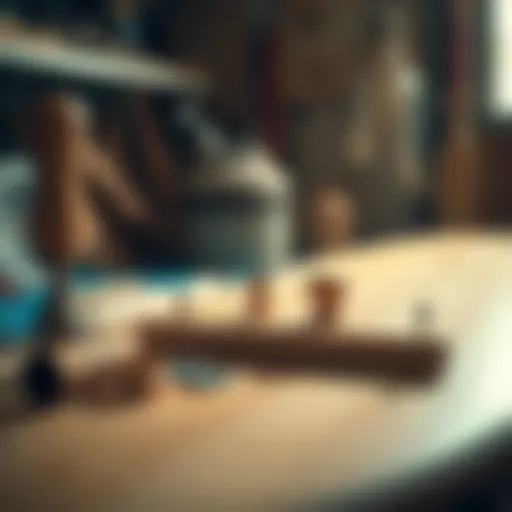Discovering Wood Skimboards: Benefits and Techniques
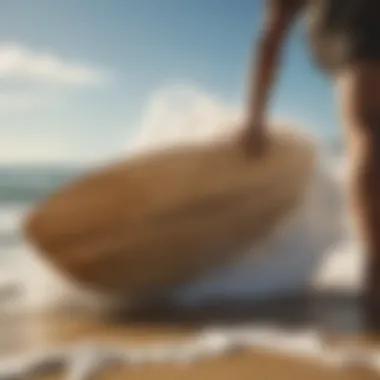

Intro
Skimboarding is more than just a sport; it's a lifestyle that beckons people to the shores, creating a connection between nature and athleticism. While one can skimboard on different surfaces, wood skimboards have carved out a niche for themselves. They bring a certain charm and a blend of tradition and performance that attracts both beginners and seasoned riders alike.
One cannot help but marvel at how these wooden boards come to life underfoot. From the smooth, handcrafted texture of mahogany to the sturdy resilience of birch, each wooden skimboard boasts unique characteristics that influence the ride. The experience of gliding over water, propelled by the sheer momentum of the board—and of course, the thrill of catching a wave—is unlike anything else.
The focus here is not just limited to the aesthetics or the feel of the board, though. It's essential to dive deep into the practical aspects—what advantages do wooden boards offer compared to their foam and composite counterparts? What are the trade-offs? Understanding these elements helps riders make informed choices and enhances their overall experience.
In this guide, we will explore vital factors to consider when selecting a wood skimboard. We will talk about riding techniques suitable for all levels, maintenance tips to keep your board in top notch condition, and even look into popular brands that have made their mark in the market. If you’re eager to enhance your skimboarding game, you’ve come to the right place.
Prelude to Wood Skimboarding
Wood skimboarding, although an underappreciated form of coastal sport, holds immense value for enthusiasts and casual participants alike. The combination of fun and skill on the water has attracted many people, providing a unique way to interact with the ocean. The exploration of wood skimboarding is not merely an analysis of equipment; it serves as a window into the culture and enjoyment of a sport that requires balance, finesse, and a sense of adventure. This article aims to illuminate the specific attributes of wood skimboards, their advantages, and the little nuances that may enhance the experience of both novice and seasoned skimmers.
Definition and Origins
At its core, skimboarding involves riding a small board over shallow water, usually in a beach setting. But what distinguishes wood skimboards from plastic or fiberglass alternatives? The distinguishing trait lies in the material—wood. Traditionally made from solid pieces of timber, these boards benefit from a unique nature, offering varying buoyancy and flexibility not found in other materials. The origins of skimboarding trace back to California in the 1920s, where beachgoers fashioned makeshift boards from wood to glide across wet sand. This simplicity has evolved into a modern-day sport that's both eco-friendly and exhilarating.
The Evolution of Skimboards
Over the decades, skimboards have morphed significantly, reflecting changes in both materials and techniques. Initially, the boards were crafted from whatever materials were available, often leading to inconsistency in performance. As the sport grew in popularity, manufacturers began producing dedicated skimboards, covering a variety of shapes and sizes.
The introduction of different wood types like birch, maple, and bamboo heralded a new age of craftsmanship, allowing for performance enhancements that plastic boards could not match. The designs grew more sophisticated, with attention to how curvature and weight distribution affected riding experience. Not only have techniques become more advanced, with tricks and stunts featuring prominently, but the materials have also pushed the boundaries of what’s possible on water.
Both in terms of personal adaptation of styles and the development of advanced manufacturing processes, wood skimboards now cater to a diverse range of riders, capturing their attention with both aesthetic and functional appeal.
"Wood skimboards combine artistry and engineering, making them a true reflection of the passion behind the sport."
With this understanding, we move forward into the characteristics of wood as a material, dissecting its benefits and limitations, as we explore the world of wood skimboarding.
Understanding Wood as a Material
In the realm of skimboarding, the choice of material plays a pivotal role in performance, aesthetics, and durability. Wood, with its distinct characteristics, shapes the riding experience in ways that are often overlooked. Understanding the properties of wood helps enthusiasts appreciate not just the boards but the nature of the sport itself.
Wood brings a unique warmth and essence that other materials can't replicate. The tactile feel, visual appeal, and even the sound it makes as it glides across the water can evoke a primal connection to nature, enhancing the enjoyment of riding. When you skimboard on wood, you engage with the material that responds dynamically to the water and the rider’s movements. This responsiveness can elevate one’s skill set, making it a favorite among many riders.
Characteristics of Wood
Wood is far more than just a material to create boards. It possesses several intrinsic features, such as:
- Natural Flexibility: Wood can bend without breaking, providing a unique feel underfoot. This flexibility allows for smoother rides, especially when tackling waves.
- Strength: Certain types of wood are surprisingly durable, capable of withstanding impact and stress from riding.
- Aesthetic Appeal: Each piece of wood has its grain and color, making every board visually unique. This allure can be a considerable factor for those who are keen on custom designs.
Types of Wood Used in Skimboards
Different woods offer varying strengths and benefits, allowing riders to select boards that suit their style or conditions. Let's dive into three prominent types of wood often used in skimboard construction.
Birch
Birch is a fantastic choice favored by many woodworkers. It provides a balance of weight and sturdiness, making it an excellent material for skimboards. Its light color and smooth finish offer a classic look while ensuring that riders maintain control during tricks and turns. One standout feature of birch is its resistance to splits, which means it can endure rough landings. However, birch can be susceptible to water damage if not treated properly, so taking care of it is essential.
Maple
Maple wood is famous for its toughness. This hardwood comes with a dense structure, making it less likely to flex excessively during high-impact rides. Riders gravitate toward maple boards because they typically offer an excellent grip, allowing for stable rides in variable conditions. The unique feature of maple is its ability to maintain a consistent performance even in wet environments. That said, maple boards can be heavier than alternatives, which might not appeal to everyone.
Bamboo
Bamboo has emerged as a popular option due to its eco-friendly nature and unique properties. It is lightweight yet surprisingly strong, making for agile boards that can turn on a dime. The aesthetic of bamboo is striking, often giving boards a modern look. Furthermore, bamboo typically possesses natural moisture resistance, which is a significant advantage in water sports. Its primary disadvantage, however, lies in the subtle flex that can lead to a less stable ride for aggressive maneuvers or tricks.
Comparing Wood to Other Materials
While wood has its charm, it's essential to compare it to other materials in the market to grasp its position.
Plastic
Plastic skimboards are popular for their affordability and resistance to water damage. They are lightweight, which eases transport. However, plastic lacks the natural feel of wood, often leading to a disconnected experience for riders. This difference can affect the board’s performance, making them less desirable for those seeking an authentic skimboarding experience.
Fiberglass
Fiberglass offers an excellent balance of durability and performance. These boards are often lightweight but can maintain high stiffness levels. The downside of fiberglass boards is their price tag; they tend to be substantially more expensive than wooden options. Their rigid nature also means riders might miss out on the alive feeling that wood provides.
EVA Foam
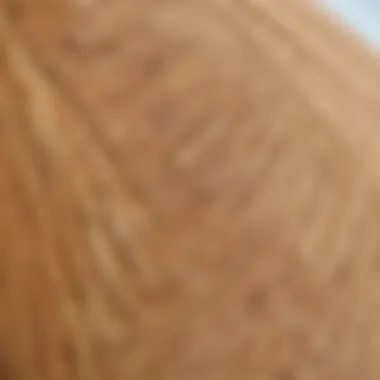

EVA foam serves as a padding material rather than a structural one, often used in conjunction with other materials. It provides excellent cushioning, allowing for comfortable landings. However, when considering performance, EVA just doesn’t stack up against wood or fiberglass in agility. This makes it not a standalone option but a complementary one.
In summary, understanding wood as a material offers keen insights into what makes wood skimboards both unique and desirable. Different types of wood each bring their own strengths, while comparison with other materials highlights wood's enduring appeal in the sport. The choice of a skimboard material has implications not just for performance, but also for the experience of skimboarding itself.
Advantages of Using Wood Skimboards
When it comes to choosing a skimboard, wood models present a set of significant advantages that can’t be overlooked. They offer unique characteristics and benefits that cater to both novice and seasoned skimmers. In this section, we will explore the reasons why wood skimboards stand out, including their natural aesthetic appeal and performance attributes that enhance the overall riding experience.
Natural Aesthetics
One can't discuss wood skimboards without appreciating their natural beauty. The grains, hues, and textures of different types of wood create a one-of-a-kind look that synthetic materials simply can't match.
- Visual Appeal: Each skimboard has a character of its own. Whether it's the light shades of birch or the rich tones of mahogany, wood skimboards present a stunning display that catches the eye.
- Customizability: Wood can be easily worked with, allowing riders to paint, varnish, or engrave their boards to express personal style. This customization adds a layer of sentimentality, often transforming a skimboard into a cherished piece.
- Connection to Nature: For many, using a wood skimboard enhances their connection to the environment, tapping into feelings of authenticity and craftsmanship that resonate deeply in a world dominated by mass production.
Performance Attributes
Performance plays a vital role in how a skimboard feels during use, and wood boards excel in several areas. Let's take a closer look at some specific performance attributes:
Flexibility
Flexibility in wood skimboards provides that extra oomph essential for skimming. It allows boards to bend slightly when encountering waves or rough surfaces, which can lead to a more forgiving ride.
- Impact Absorption: When hitting the water or small waves, a flexible board absorbs some of the shock, making it easier on the knees and joints. This is particularly advantageous for those who spend long hours skimming.
- Launching and Landing: Flexibility enables riders to launch off waves or ramps with ease, as the board offers a small spring-like action during take-off. Riders can expect smoother landings, reducing the risk of falls.
- Fine Tuning: Depending on the type of wood and its construction, flexibility can be adjusted to suit different riding styles. Advanced riders might lean towards boards that offer a slight give, while beginners may prefer something with a bit more rigidity for stability.
Grip
An equally important aspect is grip. The surface of wood skimboards often provides enhanced traction compared to plastic or fiberglass alternatives.
- Natural Surface: Many wood boards have a naturally textured surface or can be outfitted with grip pads that provide better traction, key for executing tricks and turns.
- Reassuring Control: A solid grip gives riders confidence, allowing them to focus on performance rather than worrying about slipping off their board. This factor plays a huge part in how well someone can navigate challenging waters.
- Weather Resistant Treatments: Most wood skimboards come treated to resist wear and tear, thereby maintaining grip longer than their less robust counterparts.
Speed
Speed is the heart of skimboarding and wood boards have their strengths here as well. Despite perceptions, wood can contribute to quick ride speeds if designed properly.
- Streamlined Designs: Some wood skimboards feature sleek shapes that minimize drag in the water, allowing for faster gliding. The shape of the board can significantly influence speed without sacrificing control.
- Weight Distribution: A well-made wooden skimboard can achieve an optimal balance that allows riders to maintain momentum even in less than perfect conditions.
- Responsive Performance: As riders gain experience, they may find that wood boards respond well to their weight shifts, leading to thrilling rides that feel both safe and exhilarating.
Wood skimboards are more than just a piece of equipment; they're an extension of the rider's personality and skill, allowing for a connection that transcends the act of skimming itself.
In summary, the advantages of wood skimboards include their aesthetic appeal, flexibility, grip, and speed. Each element works in harmony to create an enjoyable skimming experience, whether you're just starting or looking to improve your skills.
Challenges Associated with Wood Skimboards
When diving into the world of wood skimboarding, it is essential to also consider the challenges that come along with this choice of equipment. While wood skimboards are often praised for their aesthetics and performance, they are not without their drawbacks.
Weight Considerations
One of the first things that beginners notice is the weight of wood skimboards compared to their plastic or foam counterparts. This adds a layer of complexity when it comes to maneuvering and transporting the board. Heavier boards can be more difficult to carry, especially for those who are not accustomed to the added weight. However, while many might see this as a drawback, it’s important to note that the additional heft can contribute to stability on the water, improving overall performance in certain conditions.
For instance:
- Stability: The increased weight can absorb shock better when landing jumps.
- Wind Resistance: Heavier boards tend to be less susceptible to being blown around by the wind during rides, making them suitable during breezy conditions.
That being said, choosing the right skimboard size and shape is vital. Riders should assess their strength and riding ability, as this can dictate the type of board that suits them best without causing fatigue.
Maintenance Needs
Maintaining wood skimboards requires careful consideration and routine practices, particularly regarding how they interact with water, which can be quite different from other materials.
Water Damage
One of the major challenges with wood skimboards is the risk of water damage. Wood is naturally porous, which makes it vulnerable to absorbing water over time. This absorption harms the integrity of the skimboard. The key characteristic to remember is that wood skimboards need to be sealed properly to resist moisture ingress and prevent warping or splitting. Moreover, if waterlogged, they can lose their buoyancy and performance capabilities.
This doesn’t make wood a bad option, but it does necessitate more vigilance from the rider. Drying off the board and avoiding prolonged exposure to saltwater can make a substantial difference in longevity. Additionally, using a protective coating can extend the life by creating a barrier against moisture.
Storage Practices
Another critical aspect of caring for wood skimboards lies in their storage practices. Proper storage can significantly reduce the likelihood of water damage and prolong the board's lifespan. It's best to store a wood skimboard in a cool, dry place when not in use. Excessive heat or humidity can cause the wood to warp or split, so ensuring a stable environment is essential.
- Avoid storing the board in direct sunlight, as UV rays can degrade the finish and cause discoloration over time.
- Use a board bag when transporting it to protect against scratches and dings.
Storing the skimboard vertically can allow air circulation while minimizing direct pressure on the board's surface.
"Wood skimboards, while beautifully crafted, require a bit of extra love and care to keep them riding well for years to come."
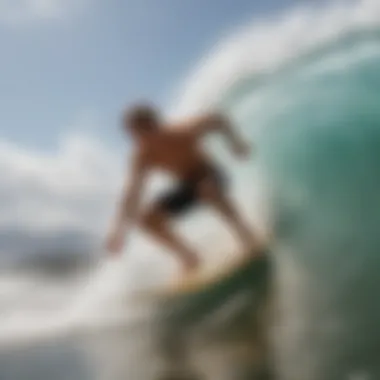

Understanding the challenges associated with wood skimboards equips riders with the knowledge needed to choose wisely and care effectively. This attention to detail in handling can enhance the overall experience and performance in the water.
Choosing the Right Wood Skimboard
When it comes to skimboarding, the choice of board can make or break the experience. Selecting the right wood skimboard is not just about personal taste; it’s crucial for performance, safety, and ultimately, enjoyment of the sport. This section digs into essential elements such as sizing, personal skill levels, and budget considerations, all of which play a significant role in guiding your decision.
Sizing and Fit
Choosing the right size of wood skimboard is akin to finding a shoe that fits well. A board too big can feel unwieldy, while one that’s too small may not provide the necessary buoyancy or stability.
- General Guidelines: Most skimboards range between 45 to 60 inches. As a rule of thumb, taller individuals might lean toward longer boards, while shorter riders would benefit from the maneuverability of a smaller model.
- Weight Considerations: Personal weight also influences the choice of board size. Heavier riders should opt for thicker boards to withstand pressure and prevent breaking, whereas lighter riders can enjoy a more delicate board that aids in agility.
- Personal Preference: Ultimately, the choice might also come down to personal preference. Some find they ride best on boards they can control easily while others prefer the stability of a larger model. Trying out different sizes can give you a better feel for what suits you best.
Skill Level Assessment
Understanding one's skill level is crucial when selecting a wood skimboard. Beginners may want to start with a more stable board, while seasoned skimboarders might search for something that offers speed and flexibility.
- Beginner Riders: Generally, beginners should opt for wider boards that provide better stability when learning the ropes. Boards with a flatter profile help in initiating turns and staying upright as one learns basic techniques.
- Intermediate to Advanced Riders: For those who have mastered the basics, exploring boards with a more pronounced rocker (the curve of the board) can enhance performance in jumps and tricks. A narrower or thinner board may allow for sharper turns and increased speed at the expense of stability.
- Rider Goals: Deciding what you want to achieve with your skimboarding also impacts your choice. Those who prioritize performing tricks should look for a board designed to handle jumps and aerial maneuvers.
Budget Considerations
Lastly, budget plays an important role in the decision-making process. Wood skimboards can range from less expensive beginner options to high-end models designed with top-quality materials.
- Entry-Level Boards: For newcomers, looking for a basic model that doesn’t break the bank is wise. A solid beginner board could range from $100 to $200 and give you solid performance without emptying your wallet.
- Mid to High Range: Once confidence and skills are solidified, investing in a mid-range or high-performance skimboard is often worthwhile. These boards typically run between $200 to $400 and often include better materials and craftsmanship, which enhance performance.
- Second-Hand Options: Moreover, don’t overlook second-hand boards as they can offer excellent value for those on a tighter budget. However, always inspect for damage or wear.
In summary, picking the right wood skimboard is a balancing act among sizing, skills, and budget. By understanding these elements, you can make a more informed choice, ensuring that your time on the water is not just enjoyable but also tailored to your unique skimboarding journey.
Techniques for Riding Wood Skimboards
Understanding the techniques for riding wood skimboards is essential for both novices and seasoned riders alike. The ability to maneuver effectively is what differentiates a casual skimboarder from a proficient one. Mastering the right techniques can not only enhance performance but also elevate the overall experience on the water. Whether you’re aiming for simple cruising or more engaging performances, the techniques covered here will prove invaluable.
Basic Riding Techniques
Basic riding techniques form the foundation of a good skimboarder. Getting these right allows for more advanced skills and ensures safety while enjoying the sport. Here are some key elements:
- Positioning: Balance is king. Stand with your feet shoulder-width apart and knees slightly bent. This stance allows for quick adjustments.
- Pushing Off: Start gently by pushing off from the ground, leaning slightly forward. This helps in picking up speed before entering the water.
- Gliding: As you hit the water, keep your weight centered. Shift your body weight towards your back foot to maintain control.
- Stopping: To stop, shift your weight gradually to your front foot and slow down your pace by dragging your back foot in the water.
These techniques seem elementary but are crucial in laying a solid groundwork for more advanced maneuvers.
Advanced Maneuvers
Once basic techniques are mastered, the next step is to explore advanced maneuvers, which can significantly enhance the thrill of riding wood skimboards.
Turns
Turns are an essential aspect of refining your control over a skimboard. The significance of turns lies in their ability to change direction smoothly and maintain momentum.
- Key Characteristic: A good turn not only allows you to change direction but also maintains speed. This is particularly useful during competition or when navigating through waves.
- Why Beneficial: Mastering turns helps in connecting even more dynamically with the water surface, giving a sense of flow.
- Unique Feature: Making sharp turns while keeping balance is indeed a unique skill, and the challenge of perfecting it adds excitement to the sport. While turns can be tricky to master, they ultimately enhance your agility and versatility on the skimboard, making them worth the effort.
Jumps
Jumps represent a statement of style and skill in wood skimboarding, often leaving spectators in awe. The art of jumping involves timing, control, and courage.
- Key Characteristic: A well-executed jump can propel riders into the air, showcasing athleticism.
- Why Beneficial: Jumps can greatly enhance the overall thrill of riding, giving the rider a moment of exhilarating freedom and an impressive display of skill.
- Unique Feature: The leap itself combines an understanding of timing, board position, and water conditions. While it requires practice, the sense of achievement after landing a successful jump can be immensely rewarding.
Safety Practices
Safety cannot be stressed enough in any water sport, especially with wood skimboarding. Here are some critical practices to keep in mind:
- Wear a Life Jacket: While not always necessary, it’s a good idea to have one on hand, particularly for beginners.
- Check the Water Conditions: Survey the area for hazards such as rocks or currents. Knowing where to ride can prevent injuries.
- Warm-Up and Stretch: Just like any other activity, prepare your body before riding to avoid strains.
- Know Your Limits: Have fun but stay within your skill set. Trying advanced tricks too soon can lead to accidents.
Remember: Safety first, fun second. Superiority in techniques brings not only performance but also safety to the forefront, ensuring an enjoyable experience on the water.
Popular Brands of Wood Skimboards
When it comes to wood skimboarding, selecting the right brand can reshape the experience. The renowned names in the industry often set the benchmark for quality, design, and performance. Understanding the attributes of specific brands can help you make informed decisions, whether you're a novice or a seasoned pro. Moreover, knowing the popular brands aids in recognizing which products are backed by proven track records in reliability and user satisfaction.
Brand Comparisons
Company A Overview
Company A has carved out a niche within the skimboard community by emphasizing craftsmanship and innovation. One striking characteristic is their commitment to traditional woodwork, favoring sustainable materials that enhance both performance and aesthetics. This approach not only pays homage to the roots of skimboarding but also attracts environmentally conscious riders.
A unique feature of Company A's skimboards is their patented flex technology that provides an unparalleled balance between sturdiness and responsiveness. Riders benefit from improved grip on the water, making it easier to execute tricks and maintain control. While some might find their boards on the pricier side, the investment pays off through durability and performance under a variety of conditions.
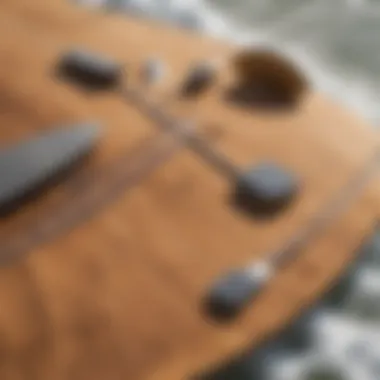

Company B Overview
Turning to Company B, this brand stands as a vanguard for integrating modern technology with classic design. Known for their vibrant graphics and customizable options, they have found canny ways to attract a younger demographic. Their boards often come with an array of color schemes and styles, which allows riders to reflect their personal flair.
Company B stands out due to its unique water-resistant coatings. These coatings not only preserve the board’s aesthetic appearance but also extend its lifespan by minimizing water damage. However, some users mention that while their designs look superb, the boards can be heavier compared to other brands, which can affect performance during more agile maneuvers on the water.
Company Overview
Lastly, Company C has gained a reputation for its focus on affordability without sacrificing quality. Their boards are particularly appealing to beginner skimboarders who are just getting their feet wet. The key characteristic that sets Company C apart is their lightweight designs, aimed at making it easier for newcomers to handle their skimboards.
The standout feature is their beginner-friendly models that have been engineered to provide stability. This allows users to gain confidence faster when learning basic techniques. On the downside, some experienced riders believe that the lightweight aspect may compromise the sturdiness seen in premium models, which could lead to issues during aggressive riding.
Each of these brands has its own identity and strengths. Depending on your needs and expertise level, one might suit you better than the others.
In summary, choosing a wood skimboard from these popular brands means evaluating what you prioritize – be it sustainability, design, weight, or performance. Your choice defines your connection to the sport and ultimately shapes your experience on the water.
Environmental Considerations
When one looks at the world of wood skimboards, there’s a pressing topic that cannot be shelved aside: environmental considerations. As we wade deeper into this thrilling sport, it becomes increasingly clear that being mindful of the materials we use and the practices we adopt is crucial not just for the riders, but for the planet as well. This section explores the importance of sustainable practices in the production and disposal of wooden skimboards, while emphasizing benefits that go well beyond personal enjoyment.
Sustainable Sourcing of Wood
The significance of sustainable sourcing of wood for skimboards can't be overstated. Every piece of wood starts its journey in a forest, and the choices made by manufacturers when sourcing can profoundly impact ecosystems. Sourcing wood responsibly means selecting timber from well-managed forests, where trees are harvested in a way that maintains biodiversity. This not only ensures that community habitats remain intact but also contributes to the health of our planet's carbon cycle.
Some wood skimboard makers are leading the charge. They prioritize wood from suppliers who practice forestry stewardship, meaning they abide by rules that limit tree removal and emphasize the replanting of new trees. This proactive approach protects the environment while offering skimboarders beautiful, high-quality products. Knowing that your skimboard is crafted from sustainably sourced materials adds a layer of peace to the adrenaline rush.
Recycling and Disposal
Once a skimboard's life on the water is over, it doesn't necessarily have to be the end of its journey. The conversation around recycling and disposal of wood skimboards presents optimal opportunities for reducing waste. Some brands are now providing recycling programs that accept old boards, ensuring they don't simply end up in landfills.
Wood is a natural material and can be repurposed in creative ways. It can be transformed into art, outdoor furniture, or even used for kindling by local communities. Not only does repurposing extend the lifecycle of materials, but it also significantly lessens the demand for new resources, which is a win-win for our environment.
Thus, when a skimboarder considers what happens to their board post-waves, it can spark an understanding of broader environmental impacts. It prompts discussions on consumer responsibility and the sustainable future of water sports.
"In the realm of recreation, we have a duty not just to enjoy, but to preserve the beauty we seek".
Enthusiasts of the sport must embrace these principles of sustainability. By choosing wisely when buying and disposing of skimboards, we contribute to the preservation of natural landscapes and support industries that have a heart for the environment. This reflects a deeper understanding that riding the waves carries responsibilities—honoring nature is essential for anyone who loves skimboarding.
Wood Skimboarding in Various Conditions
When it comes to skimboarding, the environment plays a crucial role in performance and enjoyment. Each condition demands a different approach and understanding of how wood skimboards interact with the surface and the water. Recognizing the nuances between riding on shorelines, in waves, and across flat water will empower both beginners and seasoned riders to make informed decisions and enhance their experience.
Shoreline Riding
Shoreline riding is often where many skimboarders start their journey, as it offers a forgiving environment to practice and develop skills. The sandy beach creates a soft landing, reducing the risk of injury, while the shallow water provides a safety net for beginners. Riders gain an understanding of weight distribution and balance, which is essential before tackling more challenging conditions.
In this situation, choosing a wood skimboard that is a bit wider can be beneficial. A wider board offers greater stability, which is necessary for beginners who are still finding their footing. One of the major advantages of shoreline skimboarding is the form of control it provides, allowing riders to get used to the feeling of the board beneath them. It’s also a good arena to practice various basic techniques like running with the board and learning how to drop it smoothly on the water's surface.
Wave Skimboard Riding
Wave skimboarding is where the adrenaline kicks in. Here, the stakes are a bit higher as the interaction with waves amplifies both the excitement and complexity of the sport. Successful wave riding requires an understanding of ocean currents, wave sizes, and timing. A skimboard designed for waves typically features a slightly pointed nose and a rockered tail, making it easier to glide over and cut through the surf.
Riders need to make split-second decisions on when to catch a wave and how to ride it. It's during these moments that getting accustomed to wood skimboards becomes essential, as they provide a unique grip and responsiveness in the water that other materials may not. The flexibility of wood can add to the thrill, allowing for dynamic maneuvers that can’t be achieved with a stiffer board. This not only significantly enhances performance but also boosts confidence.
"Riding waves on a wood skimboard can transform an ordinary surf day into an exhilarating adventure, but it requires respect for the ocean’s power and an understanding of one’s limits."
Flat Water Skimming
Flat water skimming presents a different challenge altogether. This environment is primarily characterized by calm water bodies like lakes or ponds, allowing for a different type of riding experience. Here, riders can focus on tricks and technical maneuvers rather than battling with waves. Wood skimboards excel in flat water due to their ability to glide smoothly on the surface, allowing riders to perform spins, flips, and other complex tricks.
When skimming on flat water, the type of wood and board design becomes even more critical. Lighter boards allow for better aerial tricks as they require less effort to lift off the water. Moreover, the craftiness of the skimboarder shines here, as riders can utilize speed and control to showcase impressive stunts. Riders can experiment with various speeds, learning how quick accelerations affect their ability to perform tricks.
Finale
The conclusion serves as a vital element in this exploration of wood skimboarding, tying together the various threads we've discussed. It crystallizes the significance of wood skimboards in the recreational water sports domain while offering insights about the practicalities involved in choosing and maintaining them. One cannot overlook the allure that wood skimboards bring to both beginners and seasoned riders alike, fostering a deeper connection with nature through the use of natural materials.
Recap of Key Points
In reviewing our findings, several key points stand out:
- Natural Appeal: Wood skimboards offer an aesthetically pleasing choice, combining functionality with beauty. The organic grains and hues of wood add character to each board, making them unique.
- Performance Benefits: Attributes like flexibility and grip enhance the riding experience, allowing users to maneuver with ease and confidence. Riders often find that wooden boards perform exceptionally well on various surfaces.
- Maintenance Awareness: It's crucial to understand the maintenance needs of wood skimboards to prolong their lifespan. Proper care prevents water damage and ensures the board remains in peak condition for riding.
- Choosing the Right Board: Matching the skimboard to individual skill level, size preference, and budget enhances the overall experience. Prospective buyers should consider these aspects carefully.
Future of Wood Skimboarding
Looking ahead, the future of wood skimboarding appears promising. As environmental consciousness grows, the preference for sustainable materials in sports equipment may continue to rise. This could lead to innovations in wood sourcing and processing that improve overall performance while reducing the ecological footprint. Moreover, with advancements in technology and design, we may expect to see new types of wood blends that enhance durability and flexibility, attracting more riders to the charm of wood skimboarding.
Furthermore, the formation of communities around this sport, particularly via platforms like Reddit and Facebook, will likely contribute to a surge in interest and participation.
In essence, the narrative of wood skimboarding is evolving, presenting a blend of tradition and modernity that resonates with people seeking not just a sport, but a lifestyle.












